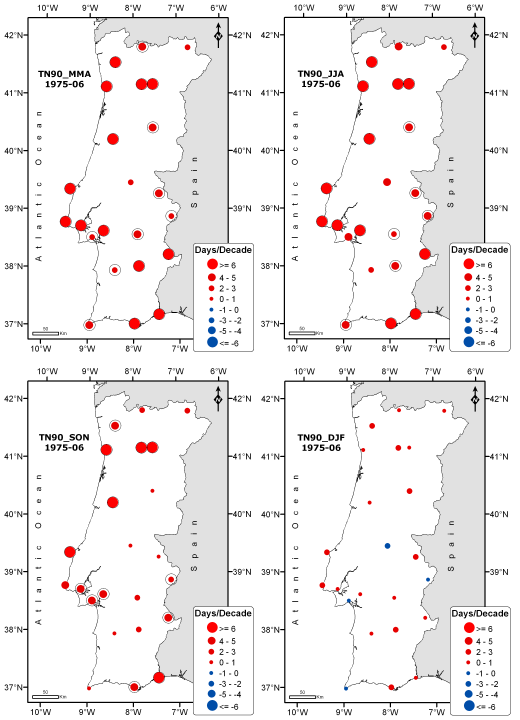Research
- Climate Variability
- Weather types
- North Atlantic Oscilation
- Blocking events
- Storm-tracks
- Cut-off low systems
- Climate extremes
- Vegetation dynamics
- Atmopsheric Rivers
- Nonlinear Analysis
- Natural Hazards
- Datasets
Climate extremes
According to the International Panel on Climate Change, in 2007, the key main vulnerable sectors in southern Europe during the 21st century are related with: 1) increased temperature extremes, provoking excessive human mortality (and other health effects) and triggering large forest fires, 2) reduced water availability due to more frequent drought events, conducing to reduced hydropower potential, and reduced crop productivity. Usually, extreme events are defined by values of meteorological variables, above or below certain thresholds, associated to low probability occurrence but with major impacts on society and eco systems (Karl et al. 1997).
The Climatology and Climate Change group has been looking in detail to changes in the frequency of different precipitation classes (including extreme precipitation) over Iberia (Rodrigo and Trigo, 2007; Gallego et al., 2011). Moreover, in recent years the group has developed a strong collaboration with the Portuguese Meteorological Office (Instituto de Meteorologia) to address in detail changes in daily surface air temperature and precipitation extremes over mainland Portugal since the early 1940s (Ramos et al., 2011, de Lima et al., 2012, Santo et al., 2012). Additionally, the group has also looked in detail to specific extreme events at the daily scale (e.g. intense precipitation over Madeira, Fragoso et al., 2012) or at the seasonal scale (e.g. the extreme wet winter of 2009-2010 in southern Iberia, Vicente-Serrano et al., 2010).

Figure 1. Decadal trends of TN90 for the last sup-period of analysis and for the: a) spring months, b) summer months, c) autumn months, d) winter months. Different sizes of the solid circles indicate different magnitudes of the decadal trends. The black circle around the solid circles represents significant trends at 5% level (Ramos et al., 2011).
References:
- de Lima Isabel, F.E. Santo, A.M. Ramos, João L.M.P. de Lima (2012) Recent changes in daily precipitation and surface air temperature extremes in mainland Portugal, in the period 1941–2007. Atmospheric Research. doi: 10.1016/j.atmosres.2012.10.001
- Fragoso M., Trigo R.M., Pinto J.G., Lopes S., Lopes A., Magro S. (2012) “The 20 February 2010 Madeira Flash-floods: Atmospheric controls and extreme rainfall assessment”. Natural Hazards and Earth System Sciences, doi:10.5194/nhess-12-715-2012, 12, 715–730.
- Gallego M.C., Trigo R.M., Vaquero J.M., Brunet M., García J.A., Sigró J, and Valente M.A. (2011) "Trends in frequency indices of daily precipitation over the Iberian Peninsula during the last century" Journal of Geophysical Research – Atmospheres, 116, D02109, doi:10.1029/2010JD014255
- Karl TR, Nicholls N, Gregory J (1997) The coming climate. Sci Am May 1997:54–59
- Ramos AM, Trigo RM, Santo FE (2011) Evolution of extreme temperatures over Portugal: recent changes and future scenarios. Clim Res 48:177–192. doi:10.3354/cr00934.
- Rodrigo, F.S, Trigo R.M. (2007) “Trends in daily rainfall in the Iberian Peninsula from 1951 to 2002”. International Journal of Climatology, 27, 513–529, DOI: 10.1002/joc.1409.
- Santo F.C., A.M. Ramos, Isabel P. de Lima, R.M. Trigo (2012) Seasonal changes in daily precipitation extremes in mainland Portugal from 1941 to 2007. Regional Environmental Change (in revision)
- Vicente-Serrano S.M, Trigo, R.M., Liberato M.L.R., López-Moreno J.I., Lorenzo-Lacruz J., Beguería S., Morán-Tejeda H., El Kenawy A., (2011) “Extreme winter precipitation in the Iberian Peninsula, 2010: anomalies, driving mechanisms and future projections” Climate Research, 46, 51-65, doi: 10.3354/cr00977